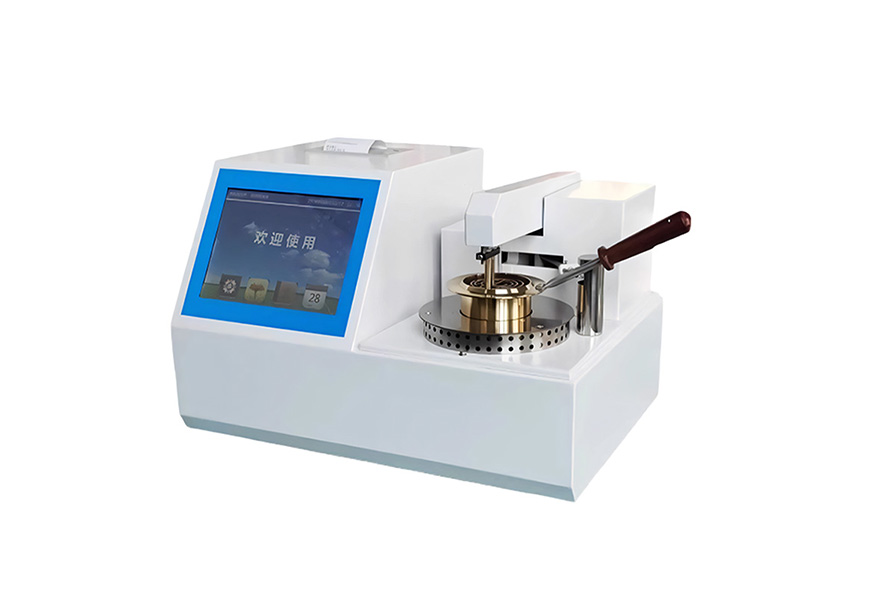
The maintenance and upkeep of the Shanghai Yetuo fully automatic open flash point and ignition point tester is an important part to ensure its long-term stability and operation. Reasonable maintenance and upkeep can extend the service life of instruments and ensure the accuracy and reliability of test results. The following is a detailed maintenance guide for the fully automatic open flash point and ignition point tester:
1、 Daily maintenance and upkeep
Instrument cleaning:
Cleaning the sample cup: After each test, the residue inside the sample cup should be cleaned immediately. Suitable solvents or cleaning agents can be used to clean the sample cup and ensure it is dry before the next use.
Cleaning the heating system and sensors: The surfaces of the heating system and temperature sensors should be kept clean to avoid sample residues and external impurities from adhering, which can affect heating efficiency and temperature sensing accuracy. Gently wipe the surface of the sensor with a clean and soft cloth, avoiding the use of corrosive cleaning agents.
Keep the exterior of the instrument clean:
Wipe the instrument casing with a soft damp cloth to prevent liquids or dust from entering the interior of the instrument and to prevent damage to internal circuits or mechanical components. Never wipe the display screen or operation panel with a damp cloth.
Regularly check the ignition device:
The ignition device is an important component of the fully automatic flash point and ignition point tester, which regularly checks whether the ignition needle, flame state, and arc ignition system are working properly. If carbon deposits or wear are found on the ignition device, it should be cleaned or replaced in a timely manner.
Cooling system maintenance:
If the instrument is equipped with a cooling system, it is necessary to regularly check whether the pipelines and liquid circulation of the cooling device are normal to ensure cooling efficiency. At the same time, maintain good ventilation in the laboratory environment to prevent overheating of instrument components caused by high temperatures.
Data storage and export:
Regularly export and backup the test data from the instrument to avoid data loss. Simultaneously clean up storage space to maintain the operation of the instrument data management system.
2、 Regular maintenance and upkeep
Temperature sensor calibration:
Temperature sensors are the core components of measuring instruments, and ensuring their measurement accuracy is crucial. Standard thermometers should be calibrated regularly, with a recommended calibration cycle of once every six months or once a year. Calibration should be carried out according to the operating procedures provided by the manufacturer to ensure the accuracy of temperature measurement.
Check the heating system:
Regularly check the working condition of the heating element to ensure its heating rate and stability. If uneven heating or abnormal heating is found, the heating element should be repaired or replaced in a timely manner.
Replacement and maintenance of ignition system:
As the usage time increases, the performance of the ignition system may decrease. It is recommended to regularly inspect components such as arc igniters and ignition needles to confirm their working status. If aging or damage is found, they should be replaced in a timely manner.
Power and cable inspection:
Regularly check the integrity of power cords, plugs, and cables to ensure that there is no aging, damage, or poor contact. When a problem occurs, the machine should be stopped immediately and inspected by professional personnel.
Instrument calibration:
In addition to the calibration of temperature sensors, other measurement and control systems also require regular calibration. It is recommended to conduct a complete instrument calibration once a year, including temperature, ignition time, data acquisition systems, etc., to ensure overall test results.
Replace consumables:
Some consumables such as sealing rings, sample cups, heating pads, etc. may age or wear out after long-term use, and should be replaced regularly according to the frequency and situation of use to ensure stable equipment performance.
3、 Long term maintenance and upkeep
Storage environment requirements:
When the equipment is not in use for a long time, it should be stored in a dry and well ventilated environment to avoid damage to the internal components of the equipment caused by humidity, high or low temperature. At the same time, turn off the power and unplug the plug to avoid power waste and potential hazards.
Professional maintenance and repair:
For critical components (such as control systems, electrical components) or major malfunctions, qualified maintenance engineers should be responsible for inspection and maintenance to avoid further damage to the instrument caused by self disassembly operations.
Software and firmware updates:
Regularly monitor firmware or software updates released by instrument manufacturers. Updating software in a timely manner can help improve instrument performance, address known issues, or add new features, ensuring that the instrument remains operational over long-term use.
4、 Maintenance precautions
Do not disassemble the instrument without authorization:
Do not disassemble the internal structure of the instrument without authorization from the manufacturer or guidance from professional personnel, in order to avoid affecting warranty rights and causing irreversible damage to the equipment.
Regular training for operators:
Regular training should be provided to laboratory operators to ensure that each user can operate the instrument correctly and reduce malfunctions or damages caused by misoperation.
Maintain a stable laboratory environment:
Keep the temperature and humidity of the environment where the instrument is placed relatively stable, and avoid adverse effects of dust, corrosive gases, etc. on the equipment. Especially when working in humid environments, attention should be paid to preventing the electrical parts of the instrument from getting damp.
Fault alarm and abnormal handling:
If there is a malfunction alarm or abnormal phenomenon in the equipment, immediately stop the machine for inspection, and handle it according to the manufacturer's operating instructions or professional maintenance guidance. Do not forcefully operate the equipment to avoid more serious damage.
5、 Summary
The Shanghai Yetuo fully automatic open flash point and ignition point tester is a precision testing instrument that requires comprehensive daily, regular, and long-term maintenance to ensure its stable performance and test results. By implementing reasonable maintenance measures, the lifespan of the instrument can be extended and the incidence of malfunctions can be reduced. Regular calibration, cleaning, and replacement of consumables, as well as proper usage methods, are all key to ensuring the operation of the instrument.


